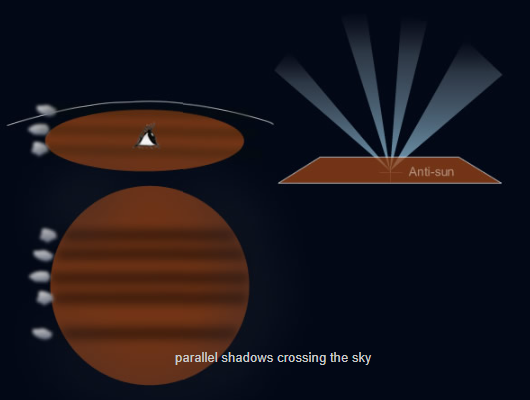OPOD - Anticrepuscular rays
OPOD - Anticrepuscular Rays: A Spectacular Atmospheric Phenomenon
Anticrepuscular rays, a mesmerizing atmospheric phenomenon, captivate the eyes of observers lucky enough to witness them. These ethereal rays of light create a breathtaking display in the opposite direction of the setting sun. While the term "anticrepuscular" suggests opposition to twilight, it is more accurately described as "anti-solar" due to their origin and behavior.
When the sun hangs low in the western sky, the interplay between clouds, shadows, and light creates a stunning visual spectacle. Anticrepuscular rays appear as bright beams that traverse the eastern sky, converging towards a point below the horizon. Jeannie Bushman's captivating images, taken south of Taos, New Mexico, beautifully capture this rare phenomenon.
The apparent convergence of the rays is an optical illusion caused by perspective. In reality, the long shadows are parallel and only appear to converge towards the point directly opposite the sun. This effect is similar to how roads and railway tracks seem to converge in the distance. The convergence point is known as the "ant-solar point" or "anti-sun," which corresponds to the opposite direction of the sun.
As the shadows approach the antisolar point, they gradually darken. This occurs because our eyes are no longer looking across the shadowed air corridors but rather along their length. The increasing depth of these shadowed air corridors results in a more pronounced darkening effect. This phenomenon adds an extra layer of mystique to anticrepuscular rays, enhancing their visual impact and making them even more captivating.
To fully appreciate the beauty of anticrepuscular rays, it is essential to understand their underlying atmospheric processes. These rays are a result of sunlight interacting with atmospheric particles, such as dust or water droplets, which scatter and redirect the light. When the sun is low on the horizon, its rays pass through a larger portion of the Earth's atmosphere, leading to more scattering and diffraction. This scattering causes the rays to appear as distinct beams of light, creating the awe-inspiring anticrepuscular display.
While anticrepuscular rays are relatively rare, they can occur under specific atmospheric conditions. These conditions include a low sun angle, an abundance of atmospheric particles for scattering, and cloud formations that act as a canvas for the rays to shine upon. The convergence of these factors is what makes witnessing anticrepuscular rays a truly remarkable experience.
It is worth noting that the article above has been automatically converted from the old website and may not appear as originally intended. However, you can find the original article here for further reference.
In conclusion, anticrepuscular rays are a fascinating and awe-inspiring atmospheric phenomenon that captures the imagination of those fortunate enough to witness them. These radiant beams of light, converging in the opposite direction of the setting sun, create a visual spectacle that leaves observers in awe. Understanding the underlying atmospheric processes and conditions that give rise to anticrepuscular rays adds to the appreciation of their beauty. So, keep your eyes to the sky and embrace the wonder of nature's breathtaking displays.

Anticrepuscular Rays
Images by Jeannie Bushman taken south of Taos, New Mexico. The sun was low in the west. The bright rays and cloud shadows crossed the opposite eastern sky and converged towards a point below the horizon. ©Jeannie Bushman, shown with permission

The shadows and rays plunge down toward the ant-solar point, the anti-sun. They are called 'anti-crepuscular' as though opposing the 'crepusculum' - twilight. 'Anti-solar' is perhaps more accurate.
The long shadows are parallel and only appear by perspective to converge towards the point directly opposite the sun. Roads and railway tracks similarly appear to converge in the distance.
The shadows darken as they near the antisolar point because the eye looks increasingly along the long corridors of shadowed air rather than across them.

Note: this article has been automatically converted from the old site and may not appear as intended. You can find the original article here.
Reference Atmospheric Optics
If you use any of the definitions, information, or data presented on Atmospheric Optics, please copy the link or reference below to properly credit us as the reference source. Thank you!
-
<a href="https://atoptics.co.uk/blog/opod-anticrepuscular-rays/">OPOD - Anticrepuscular rays</a>
-
"OPOD - Anticrepuscular rays". Atmospheric Optics. Accessed on November 26, 2024. https://atoptics.co.uk/blog/opod-anticrepuscular-rays/.
-
"OPOD - Anticrepuscular rays". Atmospheric Optics, https://atoptics.co.uk/blog/opod-anticrepuscular-rays/. Accessed 26 November, 2024
-
OPOD - Anticrepuscular rays. Atmospheric Optics. Retrieved from https://atoptics.co.uk/blog/opod-anticrepuscular-rays/.